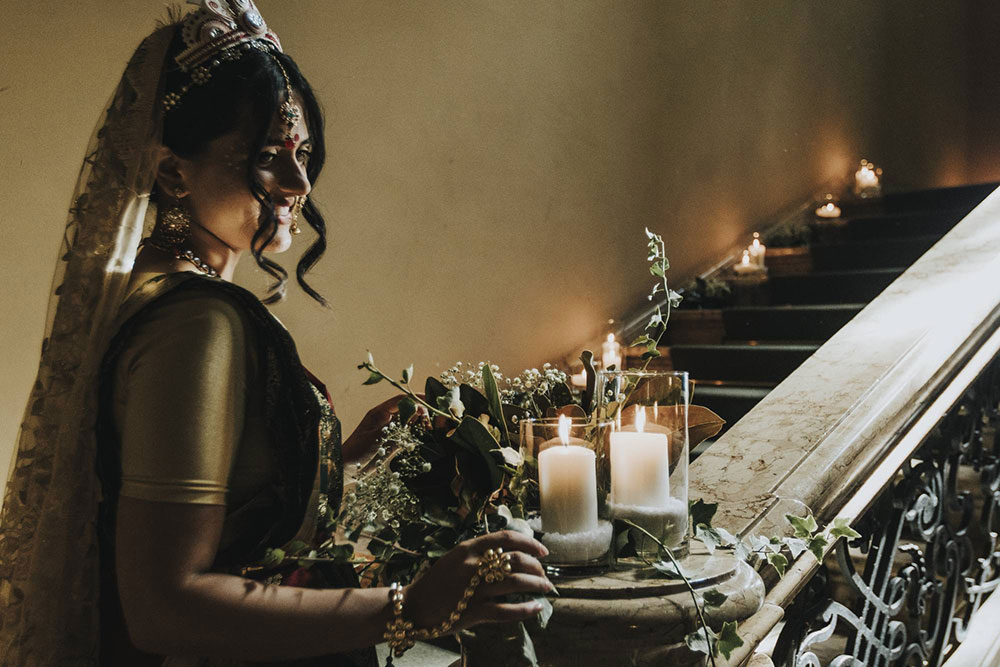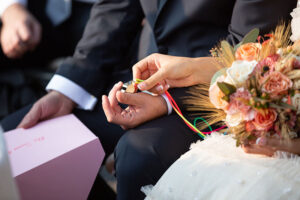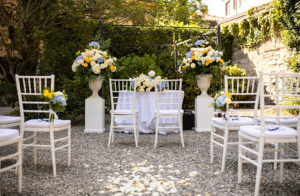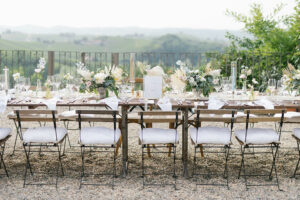In the heart of Turin, in the beautiful setting of Palazzo Ceriana Mayneri, an unforgettable Bengali Wedding Ceremony took place, a captivating blend of cultures, love, and tradition. The protagonists of this splendid day were Sumouli, a beautiful Indian bride, and Alfredo, a native of Turin who had been enchanted by the culture and traditions of Sumouli’s homeland. I had the honor and joy of officiating this wedding, which featured a dual ceremony: the first with a Bengali ritual to honor the bride, and the second with a Western ceremony to pay tribute to the groom’s country and his hometown, Turin.
The wonderful location: a historical palace in Turin
The majestic Palazzo Ceriana Mayneri, home to the Circolo della Stampa di Torino (Press Club of Turin), provided the perfect backdrop for this unique celebration. The walls steeped in history and the aristocratic atmosphere created a magical setting for this marriage that united East and West.
Today, I want to share with you some moments from their Bengali ceremony and the significance of the objects and gestures performed during the Bengali ritual.
Borondala: a tray full of gifts for the Groom
The ceremony began with the groom’s entrance, accompanied by traditional music and welcomed by Noor, a friend of the bride. Noor greeted him and offered him ritual foods: a sweet dessert, fresh fruit, and a chalice of water. A bamboo tray containing auspicious items for the couple was placed on the groom’s forehead, shoulders, chest, and knees three times as a sign of respect and acceptance into the bride’s family. This ritual is called “Borondala.”
The Bride’s entrance
The moment when the bride made her entrance, dressed in traditional Indian attire with her hands adorned with elegant henna designs, was one of the most emotional moments of the ceremony. Sumouli’s face was veiled by two leaves because she was covering her gaze, waiting to set her eyes on the groom for the first time. The bride and groom meet here and now for the first time, and this first gaze marks the beginning of their life together, where both reflect in each other’s eyes. This is the start of their union. Alfredo awaited with anticipation the moment when he could look into Sumouli’s eyes, and when it happened, both the newlyweds and the guests could barely contain their emotions. At this point, the bride and groom exchanged floral garlands around each other’s necks. This gesture within the ceremony marked the first step of mutual acceptance as husband and wife.
Gatchhora: a virtual bond between groom and bride in the Bengali Wedding Ceremony
The next ritual gesture in the Bengali ceremony involved a close friend of the couple approaching them to perform the Gatchhora, which involves tying a knot with the edges of the bride and groom’s garments. This gesture symbolizes the union of their souls for at least seven lifetimes. Arriving from far-off Bahrain to witness this crucial moment of the ceremony was Vinneth, a dear friend of the bride. The gestures were carried out with great care, leading to the climactic moment of the Bengali ceremony: the Saat Pheras, or the Seven Promises.
Saptapadi: the seven ritual steps in the Bengali Wedding Ceremony
Saptapadi is an ancient Vedic tradition dating back 5000 years, where “sapta” means seven and “padi” means steps in Sanskrit. The bride and groom take seven rounds around the sacrificial fire, reciting the seven marriage vows, with all their loved ones as witnesses. This represents the seven principles and promises they make to each other; each round is called a “phera.” Saptapadi is more than seven vows; it consists of seven sets of positive affirmations and profound prayers to the Supreme Soul or Paramatma.
According to Hindu beliefs, weddings are celebrated in heaven, and by walking seven times hand in hand around the ritual fire, the two souls unite for seven lifetimes, implying that the marriage lasts beyond death. In a Bengali wedding, the groom leads the first four pheras around the fire, followed by the bride who completes the last three with her husband following.
Meaning of the marriage vows in the Bengali Wedding Ceremony
The marriage vows are spoken by the bride and groom as expressions of their future intentions and the promises they wish to uphold in their married life. The promises encompass almost every aspect of married life, from individual roles to the promise of prioritizing each other’s happiness. The promise is to enter into the union as equals. Not only in Hinduism, during a Vedic wedding ceremony, but in all other cultures, marriage vows outline the same goals: a lifelong commitment, devotion, and mutual respect.
The Seven Ritual Vows
- The ceremony of the seven vows was performed following this ritual
- First Vow: the bride and groom walked together around the sacred fire, symbolizing Agni, the god of fire. This symbolizes prosperity and abundance in married life.
- Second Vow: during this phase, Sumouli and Alfredo vowed to cultivate strength and trust in their union, overcoming challenges together.
- Third Vow: this promise was dedicated to financial prosperity and mutual support in managing family resources.
- Fourth Vow: in this touching moment, the bride and groom promised to love and respect each other as best friends and confidants.
- Fifth Vow: the fifth promise centered on caring for loved ones, including parents and family members.
- Sixth Vow: the bride and groom pledged to share joys and sorrows, supporting each other in every aspect of life.
- Seventh Vow: the ceremony concluded with the seventh vow, an eternal commitment to remain faithful and loving to each other for life.
Each vow was emphasized with a symbolic circumambulation performed by the bride and groom, bound together by the edges of their garments. Each recited the words of commitment symbolizing the significance of each phase of married life. The ceremony of the Seven Vows was a moment of deep connection between Sumouli and Alfredo, an occasion where they expressed their love and mutual commitment in front of family and friends.
Witnesses and guests
During the ceremony, the witnesses of the bride and groom played a significant role, participating in the offerings and supporting the couple on their marital journey. These witnesses represented the community of friends and family who would support the couple throughout their married life.
The attending guests witnessed this unique ceremony with emotion, appreciating the beauty and depth of Bengali rituals. The atmosphere was filled with love, respect, and unity between two different cultures, making this wedding a truly memorable event.
An unforgettable Bengali Wedding Ceremony
The Bengali ceremony of Sumouli and Alfredo was an extraordinary event that celebrated love in all its facets. The Bengali ceremony showcased respect and appreciation for Sumouli’s culture, while the Western ceremony (which I will write about in a future post) represented the union of two kindred souls. Everyone will always remember this special day as an example of how love can overcome all cultural and language barriers. I am delighted and grateful to have had the opportunity to officiate and accompany Sumouli and Alfredo on their journey to their most beautiful day.
For more information write to me
For a special ceremony, even in multiple languages, that combines traditions and rituals from different countries, respecting the cultures and personalities of all involved, do not hesitate to contact me. Send me a WhatsApp message and book your free video call: together, we will plan and create the wedding ceremony you’ve always dreamed of.




